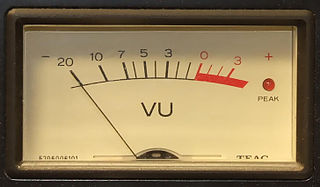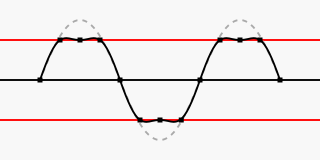The decibel is a relative unit of measurement equal to one tenth of a bel (B). It expresses the ratio of two values of a power or root-power quantity on a logarithmic scale. Two signals whose levels differ by one decibel have a power ratio of 101/10 or root-power ratio of 101⁄20.

Dynamic range compression (DRC) or simply compression is an audio signal processing operation that reduces the volume of loud sounds or amplifies quiet sounds, thus reducing or compressing an audio signal's dynamic range. Compression is commonly used in sound recording and reproduction, broadcasting, live sound reinforcement and in some instrument amplifiers.

Audio system measurements are a means of quantifying system performance. These measurements are made for several purposes. Designers take measurements so that they can specify the performance of a piece of equipment. Maintenance engineers make them to ensure equipment is still working to specification, or to ensure that the cumulative defects of an audio path are within limits considered acceptable. Audio system measurements often accommodate psychoacoustic principles to measure the system in a way that relates to human hearing.

In acoustics, loudness is the subjective perception of sound pressure. More formally, it is defined as "[the] attribute of auditory sensation in terms of which sounds can be ordered on a scale extending from quiet to loud". The relation of physical attributes of sound to perceived loudness consists of physical, physiological and psychological components. The study of apparent loudness is included in the topic of psychoacoustics and employs methods of psychophysics.
Line level is the specified strength of an audio signal used to transmit analog audio between components such as CD and DVD players, television sets, audio amplifiers, and mixing consoles.

A volume unit (VU) meter or standard volume indicator (SVI) is a device displaying a representation of the signal level in audio equipment. The original design was proposed in the 1940 IRE paper, A New Standard Volume Indicator and Reference Level, written by experts from CBS, NBC, and Bell Telephone Laboratories. The Acoustical Society of America then standardized it in 1942 for use in telephone installation and radio broadcast stations. Consumer audio equipment often features VU meters, both for utility purposes and for aesthetics.
In electronics and signal processing, full scale represents the maximum amplitude a system can represent.
Audio normalization is the application of a constant amount of gain to an audio recording to bring the amplitude to a target level. Because the same amount of gain is applied across the entire recording, the signal-to-noise ratio and relative dynamics are unchanged. Normalization is one of the functions commonly provided by a digital audio workstation.

Decibels relative to full scale is a unit of measurement for amplitude levels in digital systems, such as pulse-code modulation (PCM), which have a defined maximum peak level. The unit is similar to the units dBov and decibels relative to overload (dBO).

A peak programme meter (PPM) is an instrument used in professional audio that indicates the level of an audio signal.

The loudness war is a trend of increasing audio levels in recorded music, which reduces audio fidelity and—according to many critics—listener enjoyment. Increasing loudness was first reported as early as the 1940s, with respect to mastering practices for 7-inch singles. The maximum peak level of analog recordings such as these is limited by varying specifications of electronic equipment along the chain from source to listener, including vinyl and Compact Cassette players. The issue garnered renewed attention starting in the 1990s with the introduction of digital signal processing capable of producing further loudness increases.
Programme level refers to the signal level that an audio source is transmitted or recorded at, and is important in audio if listeners of Compact Discs (CDs), radio and television are to get the best experience, without excessive noise in quiet periods or distortion of loud sounds. Programme level is often measured using a peak programme meter or a VU meter.
Measurement of wow and flutter is carried out on audio tape machines, cassette recorders and players, and other analog recording and reproduction devices with rotary components This measurement quantifies the amount of 'frequency wobble' present in subjectively valid terms. Turntables tend to suffer mainly slow wow. In digital systems, which are locked to crystal oscillators, variations in clock timing are referred to as wander or jitter, depending on speed.
Audio noise measurement is a process carried out to assess the quality of audio equipment, such as the kind used in recording studios, broadcast engineering, and in-home high fidelity.
The alignment level in an audio signal chain or on an audio recording is a defined anchor point that represents a reasonable or typical level.
Nominal level is the operating level at which an electronic signal processing device is designed to operate. The electronic circuits that make up such equipment are limited in the maximum signal they can handle and the low-level internally generated electronic noise they add to the signal. The difference between the internal noise and the maximum level is the device's dynamic range. The nominal level is the level that these devices were designed to operate at, for best dynamic range and adequate headroom. When a signal is chained with improper gain staging through many devices, clipping may occur or the system may operate with reduced dynamic range.
Dialnorm is the metadata parameter that controls playback gain within the Dolby Laboratories Dolby Digital (AC-3) audio compression system. Dialnorm stands for dialog normalization. Dialnorm is an integer value with range 1 to 31 corresponding to a playback gain of -30 to 0 dB (unity) respectively. Higher values afford more headroom and are appropriate for dynamic material such as an action film.
EBU R 128 is a recommendation for loudness normalisation and maximum level of audio signals. It is primarily followed during audio mixing of television and radio programmes and adopted by broadcasters to measure and control programme loudness. It was first issued by the European Broadcasting Union in August 2010 and most recently revised in August 2020.

An audio analyzer is a test and measurement instrument used to objectively quantify the audio performance of electronic and electro-acoustical devices. Audio quality metrics cover a wide variety of parameters, including level, gain, noise, harmonic and intermodulation distortion, frequency response, relative phase of signals, interchannel crosstalk, and more. In addition, many manufacturers have requirements for behavior and connectivity of audio devices that require specific tests and confirmations.
Loudness, K-weighted, relative to full scale (LKFS) is a standard loudness measurement unit used for audio normalization in broadcast television systems and other video and music streaming services.








